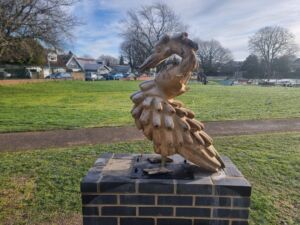Swan Jewel Sculpture
In 1965, members of Dunstable’s Manshead Archaeological Society began excavating the site of the old Friary behind Bull Pond Lane. On July 16, Maxene Miller, a local teacher, discovered a gold swan brooch now displayed in the British Museum. The brooch features white and black enamel feathers, a gold crown around the swan’s neck, and a pin for fastening to clothes or a hat.
The site was once a Dominican Friary, founded in 1259, which covered four acres between High Street South, Friars Walk, and Bull Pond Lane. The archaeologists found rubble and domestic waste from when the Friary was demolished around 1539 on the orders of King Henry VIII. The brooch was likely left behind during this demolition.
The swan symbol was linked to the Bohun family and later adopted by Henry of Lancaster in 1380. It became a badge for supporters of the House of Lancaster, including King Henry IV and his son, Henry V. The intricate enamel work suggests the brooch was made around 1400 and may have been a special gift for important Lancastrians, possibly even from the King himself.
During the Wars of the Roses, Dunstable saw significant Lancastrian military activity, including occupations in 1455 and 1461. The location of the dig can be pinpointed by nearby houses, likely Manton and Pond Cottage on Bull Pond Lane, facing Bennett’s Recreation Ground.
Text adaptation from Where the famous Swan Brooch was discovered: written by John Buckledee chairman of Dunstable and District Local History Society


 ___________________________________________________________________________________________________________
___________________________________________________________________________________________________________
The concept behind the wooden sculptures
The inspiration came from recognising notable historical significances in Dunstable as part of the High Street Heritage Action Zone (HSHAZ) scheme. Crafted entirely from English oak, the sculptures were created using wood sourced from various locations, including Leicestershire, Nottinghamshire, and a golf course near Southampton. The wood used was from trees that had been cut down as part of general land management. Dunstable Town Council commissioned sculpturer Peter Leadbeater who brought the historical vision to life.
Thanks to funding from Historic England Dunstable HSHAZ scheme (CBC) for making this sculpture possible.
